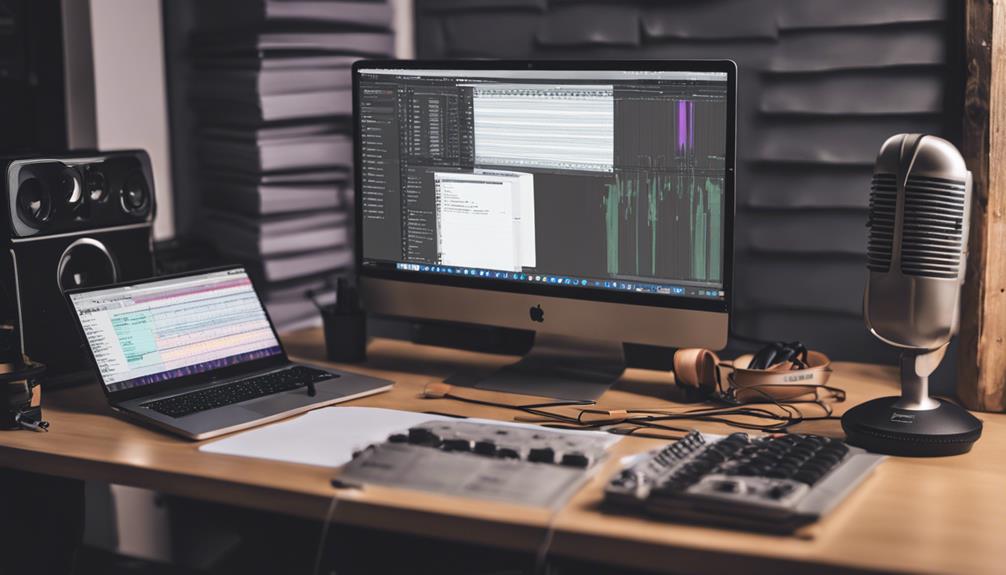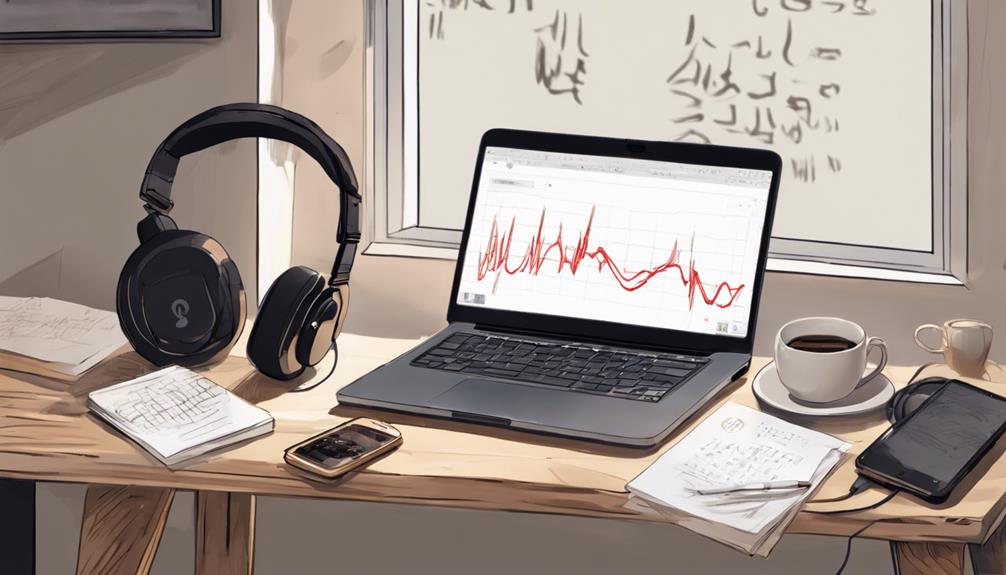To quickly transcribe Vietnamese audio into text, start by ensuring you have high-quality recordings. Utilize transcription software like Otter.ai for efficient conversions and improve audio clarity with tools like Audacity. Familiarize yourself with the dialects and listen to the audio multiple times to grasp tonal nuances. Pause and replay challenging sections, and consider using timestamps for organization. After the initial transcription, proofread while listening to catch errors. Remember to save your work in accessible formats. Implement these steps, and you'll enhance your transcription skills. Curious about additional tips and tools? There's more to explore!
Key Takeaways
- Choose high-quality audio recordings to enhance clarity and accuracy during transcription.
- Utilize transcription software like Otter.ai for quick audio-to-text conversion while ensuring language support for Vietnamese.
- Familiarize yourself with the audio by listening beforehand to understand accents and dialects.
- Break the audio into manageable segments to make transcription easier and more efficient.
Understanding Vietnamese Audio Challenges

Transcribing Vietnamese audio can be tricky due to its unique tonal qualities and diverse dialects. You might find that a single word can change meaning based on how it's pronounced, which adds a layer of complexity to your transcription efforts. If you're not familiar with these tonal nuances, you could easily misinterpret the audio, leading to inaccuracies in your text.
Additionally, Vietnamese has multiple dialects—Northern, Central, and Southern—that can vary significantly. Each region has its own pronunciation, vocabulary, and even grammar, making it essential for you to identify the dialect before you begin transcribing. You may need to familiarize yourself with these differences to ensure accurate transcription.
Moreover, background noise, speaker accents, and overlapping speech can also pose challenges. You might struggle to catch every word if speakers talk rapidly or if there's interference. Patience and practice are key. The more you work with Vietnamese audio, the better you'll understand its intricacies. By recognizing these challenges upfront, you can prepare yourself for a more effective and accurate transcription experience.
Choosing the Right Tools
To effectively tackle Vietnamese audio transcription, selecting the right tools is crucial for enhancing accuracy and efficiency. First, consider using transcription software that supports Vietnamese language input. Tools like Otter.ai or Google Docs voice typing offer speech recognition features that can save you time and effort.
Next, think about audio editing software. Applications like Audacity or Adobe Audition let you clean up background noise and adjust audio quality, making it easier to hear the nuances in the speech. You'll find that clearer audio leads to better transcription results.
Don't overlook the importance of a good headset. Investing in high-quality headphones ensures you catch every word and tone, which is particularly vital in tonal languages like Vietnamese.
Lastly, if you're looking for a human touch, explore platforms that connect you with professional transcribers who are fluent in Vietnamese. This option can provide you with a more nuanced understanding of the dialects and cultural references that automated tools might miss.
Preparing Your Audio Files

Preparing your audio files is essential for achieving clear and accurate transcriptions. Start by ensuring your recordings are of high quality. Use a good microphone and minimize background noise. The clearer your audio, the easier it'll be to transcribe.
Next, check the format of your audio files. Common formats like MP3 or WAV work best, so convert your files if necessary. If you have multiple recordings, label them clearly for easy identification later.
Listen to the audio files before you begin transcribing. This will help you familiarize yourself with the speakers' accents, speech patterns, and any specific terminology used. If the audio includes multiple speakers, make note of who's speaking to ensure you capture their words accurately.
Utilizing Transcription Software
Using transcription software can significantly streamline the process, allowing you to focus more on accuracy and less on manual typing. These tools can convert your Vietnamese audio files into text quickly and efficiently, saving you valuable time. You'll find various software options available, each with unique features tailored to different needs.
When choosing transcription software, consider its language support, particularly for Vietnamese. Some programs may utilize advanced speech recognition technology that understands accents and dialects, making the transcription more accurate. Additionally, look for user-friendly interfaces that enable you to edit and review the text seamlessly.
After uploading your audio file, the software will generate a rough transcript. You should review this output carefully, as automatic transcriptions can sometimes misinterpret words or phrases, especially in languages with tonal nuances like Vietnamese. Utilize editing features to correct errors, ensuring your final document is precise.
Moreover, many transcription tools offer collaboration options, allowing you to share your work with others for additional feedback. By leveraging the capabilities of these software solutions, you'll enhance your transcription process and produce high-quality text efficiently.
Manual Transcription Techniques

Manual transcription techniques require careful listening and attention to detail, ensuring that you accurately capture the nuances of spoken Vietnamese. Start by finding a quiet workspace free from distractions. Plug in your headphones, and play the audio at a comfortable volume. Adjust the playback speed if necessary; slowing it down can help you catch every word.
As you listen, type what you hear, using a word processor or transcription software that allows easy rewinding. Don't worry about making it perfect on the first go; focus on getting the content down. If you encounter difficult phrases or unfamiliar vocabulary, pause the audio, replay it, and take your time to decipher those sections.
Use timestamps to mark significant points in the audio, especially if the conversation shifts topics or speakers change. This will help you organize the text later. If you're unsure about tonal variations in Vietnamese, practice identifying them separately to improve your accuracy.
Lastly, take breaks to avoid fatigue. Manual transcription can be intensive, and staying fresh helps maintain your concentration and ensures you capture the audio correctly.
Editing and Proofreading
After you've completed the initial transcription, the next step involves editing and proofreading to ensure accuracy and clarity in your final document. Start by reading through your transcript while listening to the audio again. This helps you catch any missed words or phrases, ensuring you capture the speaker's intent.
As you edit, focus on correcting grammatical errors, punctuation, and formatting. Make sure the text flows naturally, reflecting the conversation's tone. If you come across any unclear sections, consider revisiting the audio for clarification. It's also wise to check for consistency in terminology, especially if specific jargon or names are used.
Once you've addressed the obvious errors, take a break before your final proofread. This fresh perspective will help you spot mistakes you might've missed earlier. Reading the transcript aloud can also highlight awkward phrasing or errors. Finally, consider having a colleague review your work. They might catch issues you overlooked and provide valuable feedback.
Taking the time to edit and proofread your transcript ensures it's not only accurate but also professional and easy to read, making it a reliable resource for anyone who uses it.
Saving and Sharing Your Transcripts

To ensure your transcripts are easily accessible, it's important to save them in a reliable format and organize them effectively. You might consider saving your files in formats like PDF or DOCX, which maintain formatting and are widely compatible. Name your files clearly, incorporating relevant details such as the date and topic for easy retrieval later.
Once you've saved your transcripts, it's time to share them. If you're collaborating with others, using cloud storage services like Google Drive or Dropbox can make sharing seamless. You can grant access to specific individuals or generate a shareable link for broader distribution. This way, everyone can access the most up-to-date version of your transcript.
Don't forget to back up your files regularly. Consider setting up automatic backups, so you won't lose any important work. Lastly, if your transcripts need to reach a wider audience, think about publishing them on online platforms or forums where interested readers can engage with your content. By saving and sharing your transcripts effectively, you'll enhance collaboration and ensure your hard work is recognized.
